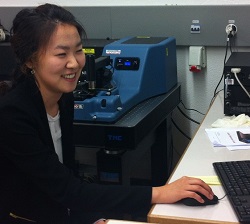ATOMIC force microscopy (AFM) has been the main analytical tool at the laboratory of physics of living matter at EPFL Switzerland, in the lab’s research into the mechanical properties of proteins, cells, and tissues. Now an Anasys NanoIR AFM-IR system is proving its value.

NanoIR in action at EPFL, operated by Dr Sunny Jeong
Dr Andrzej Kulik is a research associate at the lab, working under Professor Giovanni Dietler. Part of École Polytechnique Fédérale de Lausanne (EPFL), work here is focused on the study of DNA topology, cellular machines, and protein mechanics. Other research activities include knot hydrodynamics, DNA gel electrophoresis, cell elasticity, and cell motility.
Kulik and his colleagues are measuring the mechanical properties of proteins, cells and tissues. To date, high-resolution low temperature atomic force microscopy has been the main tool but is now complemented with the arrival of a NanoIR AFM-IR system from Anasys.
Describing his work, Kulik says “the NanoIR is presently used in two projects – antibiotic resistant bacteria, and transformation of monomers to amyloid sheets. The chemical analysis at submicron scale allows us to study small quantities of difficult-to-get proteins or even just one single bacterium at a time.
“Antibiotic-resistant bacteria are thought to have a different IR spectra to non-resistant types. If this technique is successful, it will allow us to determine quickly and at the single bacteria level the type of bacteria contained in the sample.
“Functional imaging is especially practical when an IR absorption image at the nanoscale can be quickly obtained using one well-chosen wavelength. Using the system to date, we have been amazed by the extremely low noise of the AFM part of NanoIR which gives us excellent resolution.”
Before using AFM-IR, Kulik applied multiple electron and atomic force microscopes to his research. He also used scanning near-field and acoustic microscopies. With his Anasys system, Kulik is making nanoscale measurements with the combination of AFM and IR spectroscopy.
“Our specimens are of an optimum size for the NanoIR work. Together with its open architecture design and excellent applications support have allowed us to attempt novel experiments. In short, the full potential of the technique is still for us to discover”.
